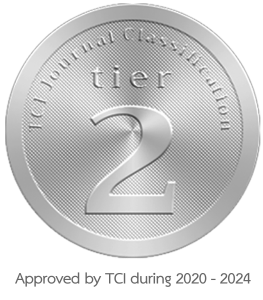Using of morphological theory to improve English reading comprehension ability of EFL students
DOI:
https://doi.org/10.62819/jel.2024.150Keywords:
English reading comprehension ability, English reading comprehension, morphological theoryAbstract
This study aimed to 1) explore the English reading comprehension problems and needs of EFL students, 2) construct the English reading comprehension handbook by using morphological theory to improve their English reading comprehension ability, and 3) evaluate the effectiveness of the English reading comprehension handbook that uses morphological theory. The population consisted of 128 first-year EFL students who had taken the BRU English proficiency test and experienced difficulties with English during the 2023 academic year. From this population, a sample of 30 participants was selected using systematic sampling techniques. The study used several research instruments to collect data which included: 1) a questionnaire to identify the problems faced by students in comprehending English reading, 2) an English reading comprehension handbook by using morphological theory, 3) pre-test and post-test, and 4) a questionnaire assessing students’ satisfaction with the English reading comprehension handbook that uses morphological theory. The results revealed that 1) most EFL students acknowledged facing challenges in English reading comprehension, with vocabulary knowledge receiving the highest, followed by fundamental knowledge, and knowledge of sentence structure, respectively. Moreover, the students express a high-level need to improve their English comprehension using morphological theory, 2) The handbook is structured into five chapters, each rooted in morphological theory to offer through assistance for students facing challenges in English reading comprehension, and 3) The English reading comprehension handbook, which utilized morphological theory, received the highest level of student satisfaction and students demonstrate higher English proficiency test scores after utilizing the English.
References
Ary, D., Jacobs, L. C., Sorensen, C., & Razavieh, A. (2010). Introduction to research education. USA: Wadsworth, Cengage Learning.
Alaeddine, M. (2016). The effective of teaching affixes on EFL learners’ reading comprehension. Department of Foreign of English. Biskra University.
Adamson, H. D. (2019). Linguistics and English literature: An Introduction. Cambridge: Cambridge University Press.
Aronoff, M., & Fudeman, K. (2010). What is morphology? Fundamental of Linguistics. Illustrated edition. United Kingdom. Blackwell Publishing company.
Brevik, L. M. (2019). Explicit reading strategy instruction or daily use of strategies? Studying the teaching of reading comprehension through naturalistic classroom observation in English L2. ReadWrit, 32, 2281-2310.
Carcia, J. R., & Cain, K. (2014). Decoding and reading comprehension: A meta-analysis to identify which reader and assessment characteristics influence the strength of the relationship in English. Review of Educational Research, 84(1), 74-111.
Chandavimol, M. (1998). Reading comprehension: An active engagement or a passive experience? PASSA Journal, 28, 31-42.
Chuanpongpanich, S. (2021). The challenges of Thailand in promoting the students’ English skills to be an effective ASEAN citizen. Santapol College Academic Journal, 7(2), 229-238.
Crocker, L., & Algina, J. (1986). Introduction to classical and modern test theory. Holt, Rinehart and Winston.
Crystal, D. (1997). English as a global language. Cambridge University Press. New York.
Elizabeth, B. (2005). Progress and Procrastination in Second Language Reading. Applied Linguistics, 25, 133-150.
Fathira, V. (2017). Analysis of EFL students’ ability in reading vocabulary of synonyms and antonyms. Lectura: Jurnal Pendidikan, 8(1), 283
Greta, G., & Etsuo, T. (2010). Developing reading fluency and comprehension using repeated reading: Evidence from longitudinal student reports. Language Teaching Research, 14(1), 27-59.
Kongcharoenkitkul, J., Nakum, N., & Chatpunnarangsee, K. (2022). A study of English reading difficulties in GAT English of Thai school students. Nakhon Pathom Rajabhat University.
Nagy, W., Anderson, R., & Herman, P. (1987). Learning the word context during normal reading. American Educational Research Journal, 24, 237-270.
Nagy, W., Anderson, R., & Herman, P. (1984). The number of words in printed school English. Reading Research Quarterly, 19(3), 304-330.
Punkasirikul, P. (2020). English reading comprehension. Khon Kaen university, Thailand.
Pisit, T. (2012). The efficiency assessment of the innovation. Bangkok, Thailand. Registration Office of Buriram Rajabhat University. (2012). Data of Reading in English course. Buriram Rajabhat University.
Richard, B. (2014). Understanding consecutive interpreting and lexical knowledge. The Journal of Interpreter and Translator Trainer, 7(1), 27-50.
Sameer, M. A. (2018). The effectiveness of designing and using a practical interactive lesson based on ADDIE model to enhance student’s learning performances in university of Tabuk. Journal of Education and Learning, 7(6), 212-221.
Sokhamkaew, S. (2016). Effects of the integration of content-based instruction on Thai EFL students’ reading comprehension. Language Institute. Thammasat University.
Srisawat, B. (2013). Introduction to Research. Imprint Published, Suweeriyasarn. Bangkok, Thailand.
Stowe, M. (2020). Teaching morphology: Enhancing vocabulary development and reading comprehension. Training & technical Assistance Center.
Sucompa, S. (1998). A survey study of current needs and problems in using technical English for tourism for the higher certificate level students Rajamangala Institute of Technology (RIT). Mahidol University.
White, T. G., Power, M. A., & White, S. (1989). Morphological Analysis: Implications for Teaching and Understanding Vocabulary Growth. Reading Research Quarterly, 24(3), 283–304. https://doi.org/10.2307/747771
Wongsuwan, S. (1992). The analysis of the problems concerning text reading skills of the Mathayomsuksa 6 students in the demonstration schools affiliated to the ministry of university affairs in Thailand. Srinakharinwirot University.
Zang, D., & Koda, K. (2013). Morphological awareness and reading comprehension in foreign language: A study of young Chinese EFL learners. Science Direct System, 41, 901-903.
Zimmerman, S., & Hutchins, C. (2023). Seven keys to comprehension: How to help your kids read it and get it. New York.



















